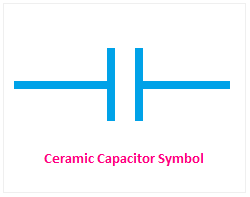A ceramic capacitor is an electronic component that is used to store electrical charge. It consists of two metal plates separated by a ceramic material that acts as a dielectric.
The capacitance value of a ceramic capacitor depends on the surface area of the plates, the distance between the plates, and the type of ceramic material used as the dielectric. Ceramic capacitors are available in a wide range of capacitance values, from picoFarads (pF) to microFarads (μF), and are used in various electronic circuits, such as power supply filtering, timing circuits, and RF circuits.
Features of Ceramic Capacitor
- Ceramic capacitors have a high dielectric constant, which allows them to store a large amount of charge in a small space.
- They have a low equivalent series resistance (ESR), which makes them suitable for use in high-frequency circuits.
- They are available in a wide range of capacitance values, from picoFarads (pF) to microFarads (μF).
- They are highly stable and have a low temperature coefficient of capacitance, which means that their capacitance value does not change much with temperature.
- They are generally small and compact, making them ideal for use in portable electronic devices.
Symbol of Ceramic Capacitor

Working Principle of Ceramic Capacitor
Ceramic capacitors consist of two conductive plates separated by a ceramic material. When a voltage is applied across the plates, an electric field is created in the ceramic material, which causes electrons to accumulate on one plate and holes to accumulate on the other plate. This separation of charge creates an electric field that stores energy in the form of electrical potential. The amount of charge that can be stored on the capacitor is proportional to the voltage applied and the capacitance of the capacitor.

Types of Ceramic Capacitor
Ceramic capacitors can be classified into two types based on the type of ceramic material used as the dielectric such as Class I & Class II Ceramic Capacitors:
Class I Ceramic Capacitors
These capacitors are made using ceramic materials with a high dielectric constant and a low loss factor. Class I capacitors have a very low temperature coefficient of capacitance, making them ideal for use in applications where high stability and accuracy are required. They have a low capacitance range from picoFarads (pF) to a few nanoFarads (nF). Class I ceramic capacitors are often used in circuits where frequency stability is critical, such as in oscillators and timing circuits.
Class II Ceramic Capacitors
These capacitors are made using ceramic materials with a lower dielectric constant and a higher loss factor than Class I capacitors. Class II capacitors have a higher capacitance per unit volume and are less expensive than Class I capacitors. They have a high capacitance range from a few nanoFarads (nF) to several microFarads (μF). Class II ceramic capacitors are used in applications where high capacitance values are required, such as in power supply filtering, decoupling, and coupling/bypassing circuits.
Class II capacitors are further classified into two subtypes based on the ceramic material used as the dielectric:
- X7R Ceramic Capacitors: These capacitors have a moderate temperature coefficient of capacitance and offer a balance between capacitance value, size, and cost. They are widely used in general-purpose applications such as decoupling and bypassing circuits.
- Y5V Ceramic Capacitors: These capacitors have a high capacitance per unit volume but a high temperature coefficient of capacitance. They are less stable than X7R capacitors and are mainly used in non-critical applications such as coupling and bypassing circuits.
Applications of Ceramic Capacitor
Ceramic capacitors are widely used in electronic circuits due to their small size, low cost, and high capacitance values. Some of the common applications of ceramic capacitors are:
- Power supply filtering and decoupling
- Timing circuits
- Oscillator circuits
- Radio frequency (RF) circuits
- Audio circuits
- Voltage regulation
- Coupling and bypassing circuits

